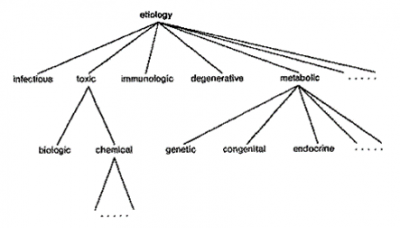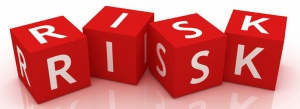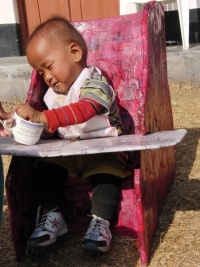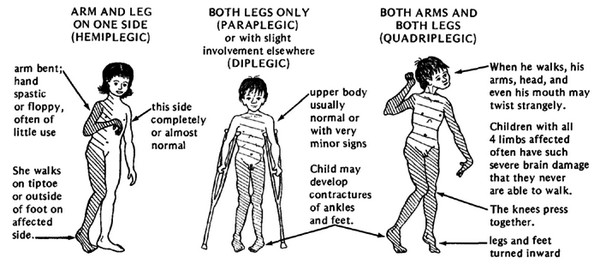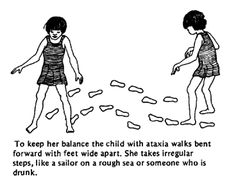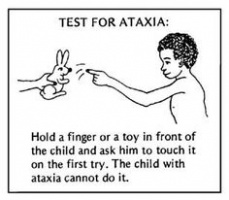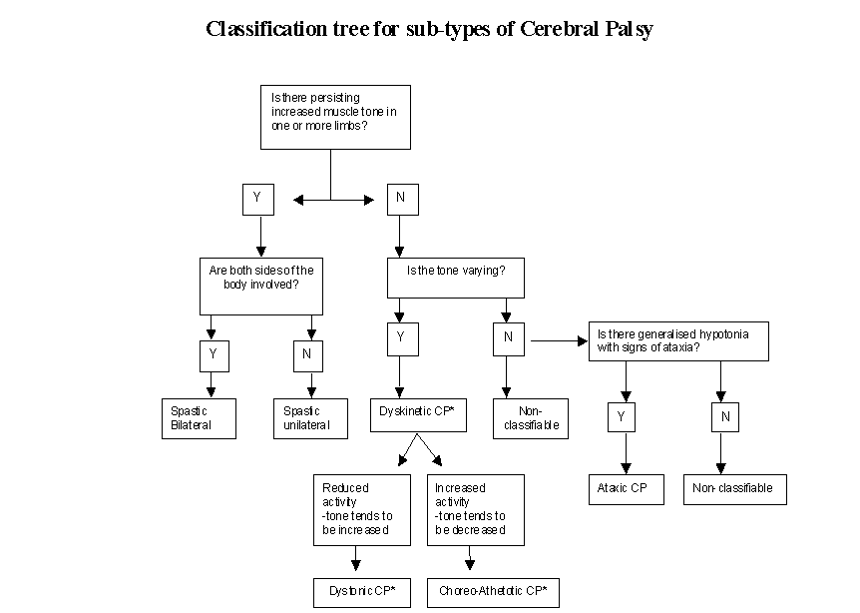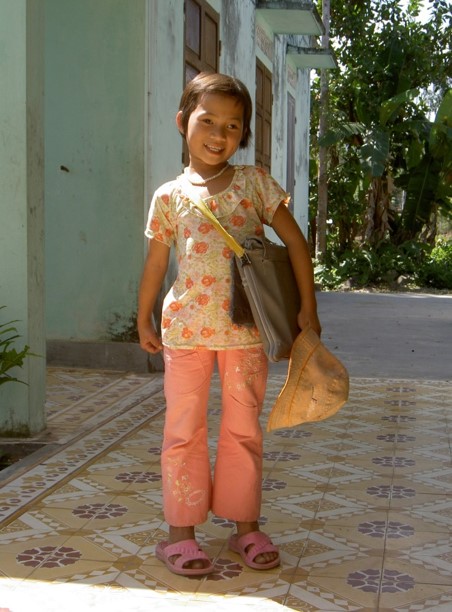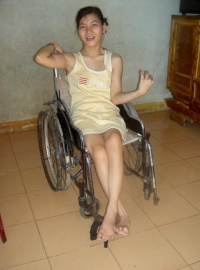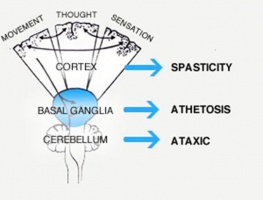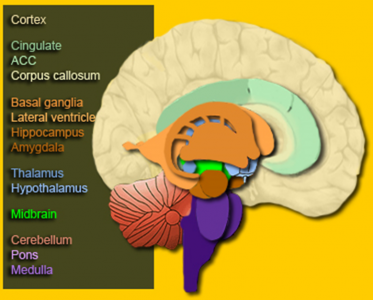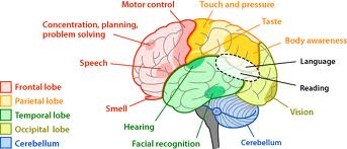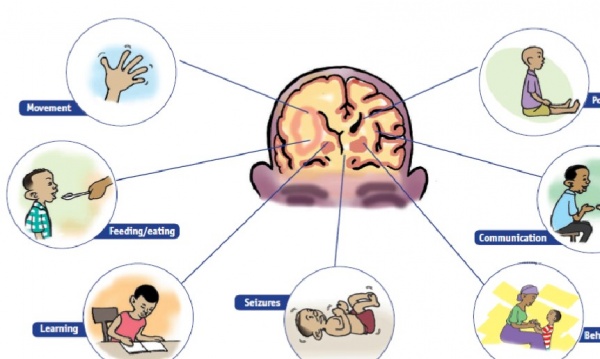Cerebral Palsy Introduction: Difference between revisions
Michelle Lee (talk | contribs) No edit summary |
Scott Buxton (talk | contribs) No edit summary |
||
| Line 281: | Line 281: | ||
<br> This image gives a nice pictorial overview of the problems experience by children with CP | <br> This image gives a nice pictorial overview of the problems experience by children with CP | ||
[[Image:Problems in CP children.jpg|center|600x500px]] | [[Image:Problems in CP children.jpg|center|600x500px]] | ||
[[Category:Cerebral_Palsy]] | |||
Revision as of 19:28, 6 July 2016
Introduction
[edit | edit source]
The information on this page has developed for you from the expert work of Roelie Wolting alongside the Enablement Cerebral Palsy Project and Handicap International Group.
This page will provide you with information on Cerebral Palsy (CP) such as:
- Definitions,
- Causes
- Epidemiology and aetiology.
This page will provide you with knowledge and better understanding of CP and how it affect children and their families.
Definition[edit | edit source]
Cerebral Palsy (CP) is a disorder of movement and posture that appears during infancy or early childhood resulting from damage to the brain. The damage to the brain is permanent and cannot be cured but the earlier we start with intervention the more improvement can be made.Any non-progressive central nervous system (CNS) injury occurring during the first 2 (some say 5) years of life is considered to be CP.
There are several definitions of Cerebral Palsy within the literature, although these may all vary slightly in the way they are worded they are all similar and can be summerised to:
Cerebral Palsy is a group of permanent, but not unchanging, disorders of movement and/or posture and of motor function, which are due to a non-progressive interference, lesion, or abnormality of the developing/immature brain.
This definition specifically excludes progressive disorders of motor function, defined as loss of previously acquired skills in the first 5 years of life.
Time Frame of Brain Injury[edit | edit source]
We only talk about cerebral palsy if the brain damage arises during one of the following periods:
Prenatal period:
- Conception to the onset of labor
Perinatal period:
- 28 weeks intrauterine to 7 days
Postnatal period :
- First two (and some say five) years of life
After the age of 5 we speak of stroke or traumatic brain injury.
Epidemiology[edit | edit source]
The incidence of CP has not declined despite the improved perinatal and obstetric care. Even at centres where optimal conditions exist for perinatal care and birth asphyxia is relatively uncommon, the incidence of CP in term babies has remained the same.
The overall prevalence, all over the world, increased during the last decades, because of increased survival.Here are some facts on the epidemiology of CP:
- The incidence is 2-2,5/1000 live births in Western Countries.
- Some affected children do not survive.
- The prevalence varies between 1-5/1000 babies in different countries.
- There are no reliable statistics from Asian countries.
Aetiology[edit | edit source]
Improved medical care have decreased the incidence of CP among some children, medical advances have also resulted in the survival of children who previously would have died at a young age.
The type of cerebral palsy has also changed:
- In the 60’s around 20% of children with CP had athetoid/dyskinetic cerebral palsy.
- Today only 5 or 10% have this type and 80-90% have spastic CP.
- This decrease is mainly due to advances in the treatment of hyperbilirubinamia.
- The increase of spastic cerebral palsy is because of higher survival rates for (very small premature) babies.
- The most common cause is idiopathic, which means that the cause of damage to the brain during pregnancy is not known.
Risk Factors[edit | edit source]
There are different risk factors for each stage at which a child might develop CP. These can be broken down into; Prenatal, Perinatal and Postnatal.
Prenatal:
- Prematurity (gestational age less than 36 weeks)
- Low birth weight (less than 2500 g), which could be due to poor nutritional status of the mother
- Maternal epilepsy
- Hyperthyroidism
- Herpes simplex virus
- Infections (TORCH = toxoplasmosis, rubella, cytomegalovirus
- Severe toxemia, eclampsia
- Drug abuse
- Trauma
- Multiple pregnancies
- Placental insufficiency
Perinatal:
- Premature rupture of membranes
- Prolonged and difficult labor
- Vaginal bleeding at the time of admission for labor
- Bradycardia
Postnatal (0-2 years):
- Central Nervous System infection (encephalitis,meningitis)
- Hypoxia
- Seizures
- Coagulopathies
- Neonatal hyperbilirubinemia
- Head trauma
There is no way to predict which children’s brain will be damaged by one of these factors, or to what the extent of the damage will be. None of these factors always results in brain damage; and even when brain damage occurs, the damage does not always result in CP.
For example: Some children may have an isolated hearing loss from their meningitis, others will have severe intellectual disability, and some will have CP.
Sub Types of CP[edit | edit source]
There are 3 sub-types of CP and these are:
- Spastic
- Dyskinetic
- Ataxic
Even though they are not clinically precise and may lack reliability, amoungst observers these terms can be conceptually useful.
Spastic CP[edit | edit source]
Spastic Cerebral Palsy is characterised by at least two of the following symptoms, which may be unilateral (hemiplegia) or bilateral:
- Abnormal pattern of posture and/or movement
- Increased tone (not necessarily constantly)
- Pathological reflexes (hyper-reflexia or pyramidal signs e.g. Babinski response)
Dyskinetic CP[edit | edit source]
Dyskinetic Cerebral Palsy is Characterised by the following Symptoms:
- Abnormal pattern of posture and/or movement, and
- Involuntary, uncontrolled, recurring, occasionally stereotyped movements of affected body parts
Dyskinetic Cerebral Palsy may be either:
- Dystonic Cerebral Palsy, dominated by both hypokinesia and hypertonia.
or
- Choreo-athetotic Cerebral Palsy, dominated by both hyperkinesia and hypotonia
Ataxic CP[edit | edit source]
Ataxic Cerebral Palsy is characterised by the following symptoms:
- Abnormal pattern of posture and/or movement
- Lost of orderly muscular co-ordination, so that movements are performed with abnormal force, rhythm and accuracy
Classification Tree for Sub-types of CP[edit | edit source]
Many children with cerebral palsy have a mixed form of cerebral palsy.
In this page the definition and classification used as agreed on in Europe. More information on definitions, outcome of some studies, exchange of information on clinical practice on CP in Europe you can find, after registering here.
The Surveillance of Cerebral Palsy in Europe was established in 1998.
Anatomical Classifications[edit | edit source]
Anatomical classification are as follows:
- Unilateral: one side of the body is affected
- Bilateral: both sides of the body are affected
- Spastic CP: are used to distinguish between quadriplegia, diplegia and hemiplegia. Diplegia mainly affects the upper limbs in comparrison the lower limbs.
Spastic CP is either bilateral or unilateral.
- Unilateral CP: we refer to as hemiplegia.
- Dyskinetic CP and Ataxic CP: always involve the whole body (bilateral).
Spacticity [edit | edit source]
Spasticity is defined as an increase in the physiological resistance of muscle to passive motion. It is part of the upper motor neuron syndrome characterized by hyperreflexia, clonus, extensor plantar responses and primitive reflexes. Spastic CP is the most common form of CP. Approximately 80% to 90% of children with CP have spastic CP.
Traditionally we recognized 3 types of spastic CP:
| Hemiplegia | Diplegia | Quadriplegia |
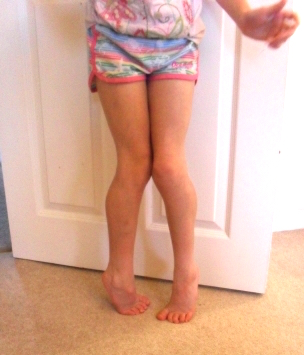
|
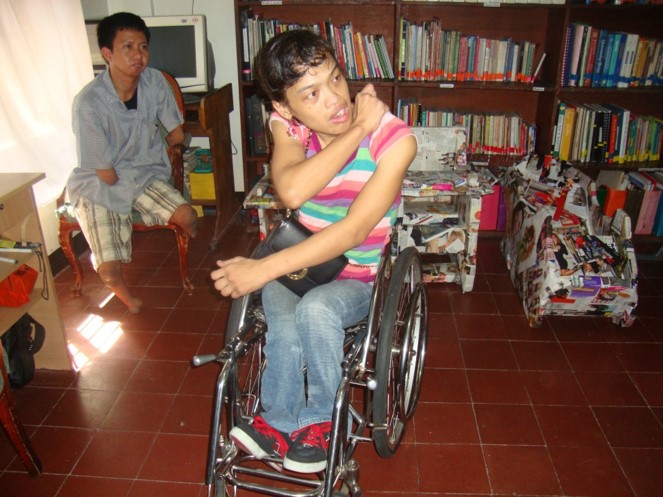
|
Hemiplegia (unilateral) CP[edit | edit source]
With hemiplegia, one side of the body is involved with the upper extremity generally more affected than the lower. Seizure disorders, visual field deficits, astereognosis, and proprioceptive loss are likely. Twenty percent of children with spastic CP have hemiplegia. A focal traumatic, vascular, or infectious lesion is the cause in many cases. A unilateral brain infarct with posthemorrhagic porencephaly can be seen on magnetic resonance imaging (MRI).
Diplegia (bilateral) CP[edit | edit source]
With diplegia, the lower extremities are severely involved and the arms are mildly involved. Intelligence usually is normal, and epilepsy is less common. Fifty per cent of children with spastic CP have diplegia. A history of prematurity is usual. Diplegia is becoming more common as more low- birth-weight babies survive. MRI reveals mild periventricular leukomalacia (PVL).
Quadriplegia (bilateral) CP[edit | edit source]
With quadriplegia, all four limbs, the trunk and muscles that control the mouth, tongue, and pharynx are involved. Thirty percent of children with spastic CP have quadriplegia. More serious involvement of lower extremities is common in premature babies. Some have perinatal hypoxic ischemic encephalopathy. MRI reveals periventricular leukomalacia (PVL).
Dyskinetic CP[edit | edit source]
Abnormal movements that occur when the child initiates movement are named dyskinesias. Dysarthria, dysphagia, and drooling accompany the movement problem. Intellectual development is generally normal, however severe dysarthria makes communication difficult and leads the outsider to think that the child has intellectual impairment. Sensorineural hearing dysfunction also impairs communication. Dyskinetic CP accounts for approximately 10% to 15 % of all cases of CP. Hyperbilirubinemia or severe anoxia causes basal ganglia dysfunction and results in dyskinetic CP.
Ataxic CP[edit | edit source]
Ataxia is loss of balance, coordination, and fine motor control. Ataxic children cannot coordinate their movements. They are hypotonic during the first 2 years of life. Muscle tone becomes normal and ataxia becomes apparent toward the age of 2 to 3 years. Children who can walk have a wide-based gait and a mild intention tremor (dysmetria). Dexterity and fine motor control is poor. Ataxia is associated with cerebellar lesions. Ataxia is often combined with spastic diplegia. Most ataxic children can walk, but some need walkers.
Mixed CP[edit | edit source]
Children with a mixed type of CP commonly have mild spasticity, dystonia, and/or athetoid movements. Ataxia may be a component of the motor dysfunction in children in this group. Ataxia and spasticity often occur together. Spastic ataxic diplegia is a common mixed type that often is associated with hydrocephalus.
The Brain[edit | edit source]
Here are some of the clinical terminology used when talking about CP:
- Tonus
- Lesion Site
- Spastic
- Cortex
- Dyskinetic
- Basal Ganglia - Extrapyramidal System
- Hypotonic / Ataxic
- Cerebellum
- Mixed
- Diffuse
Knowing were the damage could be located will not influence your interventions. Look at the following pictures of the brain to understand the relationship between the location of the damage and the symptoms.
Problems Regularly Seen with Children with CP[edit | edit source]
This table highlights the problems that children with CP experience within different areas.
| Neurological | Musculoskeletal | Associated Problems |
|
|
|
This image gives a nice pictorial overview of the problems experience by children with CP




